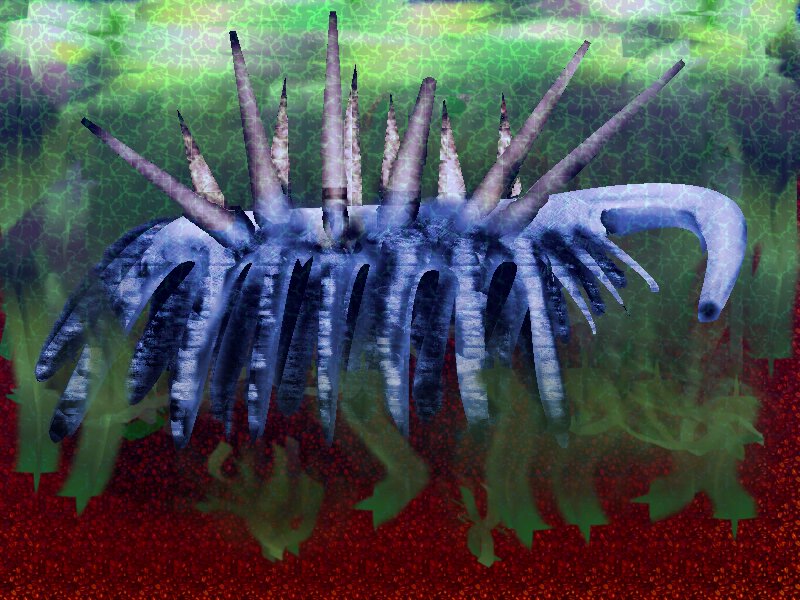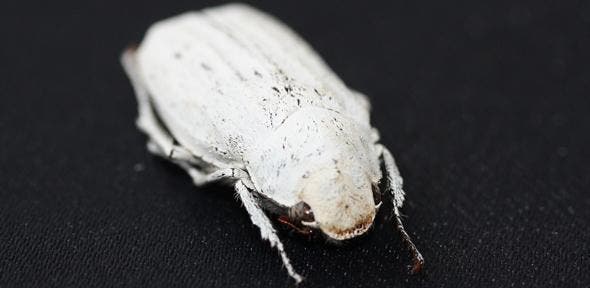Search Results for Tag: biodiversity
The whitest white of all – #speciesoftheweek
What exactly comes into your mind if you think about the color white? You will think of paper, milk, maybe teeth or little lambs. But I am very sure that you would not think of a beetle. But it is a beetle that comes in a white that is more white than all other white things you most likely have in mind.
The beetle goes by the name of Cyphochilus, it is native to South-East Asia. The reason for its pearly-white appearance is a thin layer of a highly reflective natural photonic solid in the beetles scales, as ZME science writes. Cyphochilus gained this ability during a long evolutionary process to become invisible among its close neighbors, an also very white funghi. And this has a great advantage: the better the disguise, the more likely the beetle will survive, as birds can’t see and eat it.
For humans the ability of Cyphochilus is important, because it could reveal the secret to develop even whiter paper, wall color, plastic or shiny white parts in tech devices. Therefore Cyphochilus is our #speciesoftheweek.
462 birds – our #numberoftheweek

Bird in the Sun (Photo: CC BY 2.0, Misty via flickr.com: http://bit.ly/1zaWbqD)
Now it’s time for some good news, our soaring #numberoftheweek: The world could contain 462 more bird species than previously thought. 462! That’s really something!
But how can it be that such a large number of bird species had remained undiscovered until now? Did the birds hide somewhere? In large trees? Underground? No, of course not. The discovery follows one of the most comprehensive analyses of today’s known bird species.
As a result, hundreds of birds that had been regarded as sub-species were in fact thought to be different enough to be considered separate species. (via The Independent)
Hallucigenia sparsa has found a home

Artists rendereing of Hallucigenia (Photo: Scorpion451 // CC-BY-SA-2.5. wikipedia: http://bit.ly/1wgt2hA)
When Charles Doolittle Walcott discovered the first Hallucigenia sparsa, a strange looking creature with lots of spikes and legs, he started a classification discussion that would last for more than 100 years. Until recently the bizarre fossil had not found it’s place in the evolutionary Tree of Life – nobody could tell what it actually was. As you can see on the picture above, the critter looks a lot like something you might find in your nightmares. And it’s looks are also the reason for Hallucigenias being used as the creature’s names. It’s said to be a reference to the “dreamlike” appearance of the species.
Creature from the abyss
Around 500 million years ago, the millipede-like creature with spikes lived during the Cambrian Explosion, a period in Earth’s history when most major animal phyla appeared in a relatively short amount of time. We are talking about a period of between five to 10 million years. Science has a lot of evidence in the form of fossils from this time.
The Hallucigenia were between five and 35 millimeters in length, and lived on the floor of the Cambrian oceans.
Finally the journey ends
So, now scientists of the University of Cambridge’s Department of Earth Sciences have finally classified Hallucigenia sparsa as an ancestor of the modern velvet worm. The research was published in the Aug. 17, 2014, issue of the journal Nature.
Eating our way through endangered species
Jennifer Seitz ponders humans’ seemingly insatiable appetite for exotic and wild meat – one that’s driving critically endangered species like the pangolin to the brink of extinction.
Man is the world’s most insatiable and efficient predator. His highly developed intelligence and the use of weapons and arms gives him the opportunity to kill opponents who normally would be much superior in the wild.
Furthermore, humans are ‘super-predators’ because they don’t just decide for one predator-prey system, but decide to get for all animals they feel threatened by. Although humans have managed to domesticate a lot of animals like cows, pigs and poultry they’re not satisfied with it. Nope. They also love to eat exotic animals. And they’re doing it in such a frenzied way that these animals are nearly extinct. That’s what happened to pangolins. Their meat is so highly coveted in China and Vietnam, that all eight pangolin species were upgraded on the IUCN Red List of Threatened Species. They’re critically endangered and the most illegally-traded mammals in the world – a sad record.
And because pangolins in Asia are becoming scarce, a booming pangolin trade in Africa has developed. Even there, the little scaly anteaters with their sticky tongues aren’t safe anymore.
But hey humans, don’t worry. When the pangolins have disappeared, there are still enough other endangered species which can be eaten to extinction.
More information can be found here.
I’ll scratch your back if you scratch mine
By Jennifer Seitz
It’s hard to be a wild animal. As if it wasn’t enough that their habitats are threatened and they are challenged by climate change, they are also besieged by humans equipped with cameras and spyglasses to watch their every little twitch.
“Enough with that!,” the Samango monkeys (Cercopithecus albogularis) in South Africa may have thought. ‘If you’re hanging out in our place, we might as well put you to good use and make you our bodyguards!’
Monkeys opting for a human security detail? Well, this is what a new scientific study published in the magazine Behavioral Ecology suggests. According to the study the monkeys use field researchers as human shields against predators. The researchers, headed by Katarzyna Nowak from Durham University have shown in an experiment that the monkeys felt much safer and stayed longer at their feeding sites when people were around.
The furry fellows are not only eating longer in the company of human onlookers, it has also made them change their snack locations. Like most of their colleagues Samango monkeys gobble up their food up in the trees where they are safe from ground-based predators. While observing trees, which had been prepared with feed buckets at different heights the researchers discovered that the monkeys enjoyed their meals closer to the ground than usual, because they seemed to feel even safer in the presence of the researchers.
Quite clever these little fur balls!
But Nowak and her team raised another serious point well beyond their clever monkeys. How accurate can behavioral studies with animals actually be when the mere presence of the researchers is enough to change their behavior
Who knows what’s going on in the forest when nobody is watching?!











Feedback